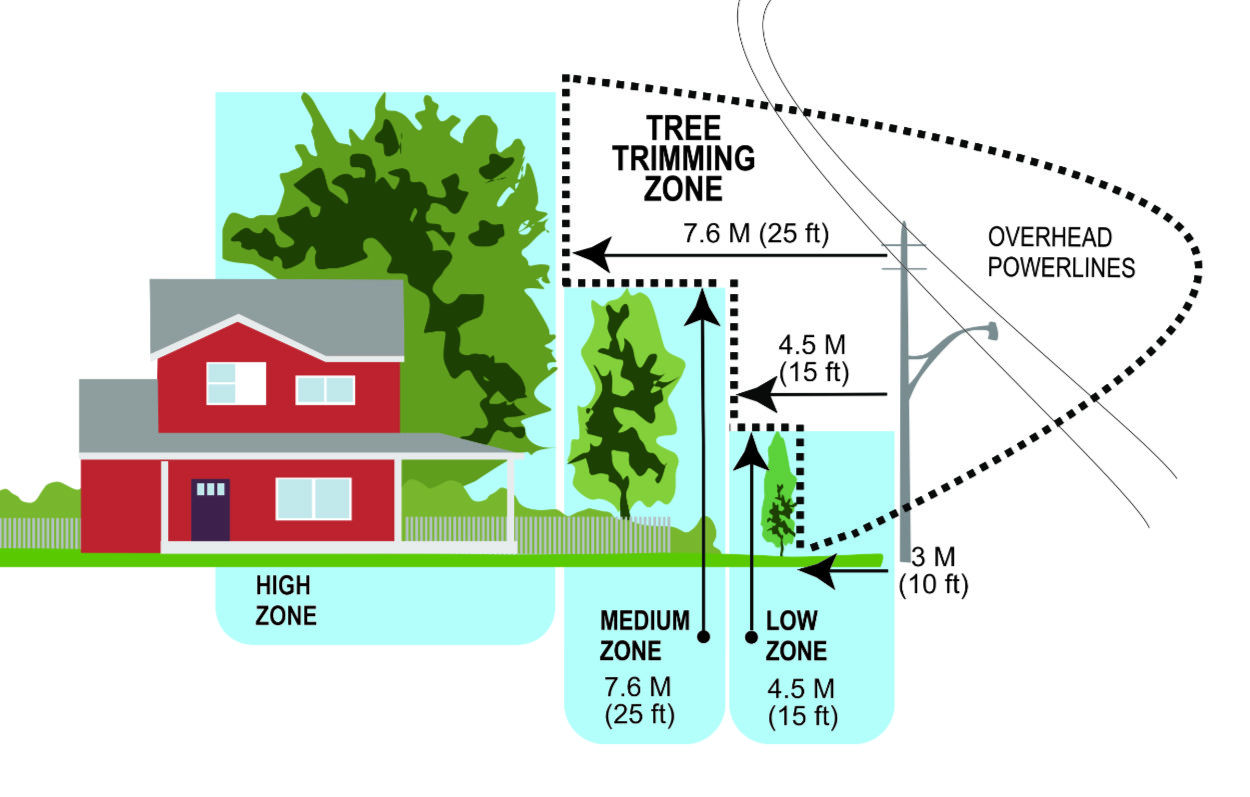Engineering Technical Bulletin
Tree Planting and Trimming Clearances
Trees, shrubs or vines that grow too close to overhead electrical infrastructure present potential hazards including fires, power outages, or electrocution caused by direct or indirect contact.
Tree Trimming Zones: Understanding Overhead Clearances
Clearance requirements for trees are shown in Table 1 and Figure 1.
When selecting trees for planting, it is important to consider that different varieties grow at different rates. Those that grow faster will need to be trimmed more often or be planted farther from overhead electrical infrastructure.
Trees, shrubs, and vines should never be placed closer than 3 metres (10 feet) from the base of an electrical pole.
Table 1: Tree Trimming Zones
The three tree planting zones are outlined in this table. Consult figure 1 for a visual reference.
| Tree Planting Zone |
Clearance Requirement |
|---|---|
| Low | Trees and shrubs planted under electrical lines should have a maximum mature height and spread of 4.5 metres (15 feet). |
| Medium | The maximum mature height and spread of trees planted from the outer edge of the Low Zone in all directions, is 7.6 metres (25 feet) from OH lines. |
| High |
The High Zone extends from the outer edge of the Medium Zone, and measures 7.6 metres (25 feet) from the overhead lines. At maturity, trees planted in this zone should not encroach on the Medium Zone. |
Figure 1: Tree Trimming Zones

Three Tree Planting Zones - High, Medium and Low – The maximum heights and clearances required from electricity poles and wires are illustrated. The zones and applicable clearances are outlined in Table 1.
Tree Trimming
A tree that grows too close to overhead electrical lines will need to be trimmed to maintain a safe clearance of 3 metres (10 feet). As part of Burlington Hydro’s ongoing commitment to provide reliable service, a comprehensive tree trimming program is in place. A rotating 3-year maintenance schedule – covering all of Burlington Hydro’s service territory - is aimed at mitigating outages that are caused by tree limb contacts. View the 2025 Tree Trimming Schedule.
Underground Clearance
When planting in the vicinity of underground electrical infrastructure, the minimum clearance required from the edge of the root ball to the edge of underground cables or duct structure is 1 metre (3 feet). This protects the electrical infrastructure and reduces damage to the roots of the trees should Burlington Hydro need to access its equipment. If the minimum distance cannot be achieved, Burlington Hydro may require the installation of a root deflector against the root ball..
Locates
Underground electrical infrastructure may be buried and can be at different depths. When planting a tree, a locate must be requested before digging.
Call or click Ontario One Call before you dig to arrange a FREE underground locate.
- Call Ontario One Call, 24-hours-a-day, 7-days-a-week at 1-800-400-2255
- Or submit an online request on the Ontario One Call website
Excavation
Tree planting and removal can involve deep excavations that have the potential to cause damage to underground infrastructure. The excavation method (i.e. hand, vacuum, or pneumatic tools, as approved by Burlington Hydro) must protect the underground electrical infrastructure if digging will occur within 1 metre (3 feet).
